This post is sponsored by Traeger Grills. They sent me their Pro Series Grill to try out and play around with!
Anyone who has been even a casual Macheesmo reader will know that I’m a grilling fanatic. Especially in the summer, I love sitting out and grilling with friends on a casual Saturday, but I also use the grill for weekday meals with the family. Over the years, I’ve amassed quite the list of grills including:
- Two gas grills
- One charcoal grill
- One Electric smoker
And so I’m fairly careful on what new gear I add to my grilling arsenal just because I’m running out of room! But, when I got the offer to test out a Traeger Grill, something I had heard about but never personally tried, I had to accept.
What is This Traeger Thing?
The Traeger team has really created something interesting with their grills. The grill is a wood fired grill (uses wood pellets and electric heat) so you get a nice mix of gas grilling functionality (ease of use) with great flavor from the wood fired pellets.
The first thing I noticed when using the Traeger is A) how sturdy it is but B) how thoughtful the design is. It seems like they thought of everything. Example? They not only have TWO probe thermometers so you can keep an eye on two different cuts of meat, but they have an insulated port to easily get the probes into the grilling area. Cool stuff.
So the grill is basically half grill, half smoker, half oven. I realize that that is 1 1/2 things, but that kind of fits this grill.
The Setup and Prep
I had to set this sucker up myself and it took me about three hours. I would not rush it. Get a friend to help you. The instructions for the setup even have guides on when you should open your next beer.
To be honest, I’ve set up gas grills that were harder to configure (due to all the gas connections), but this grill is heavy and there are enough parts that it’ll take you an afternoon.
More importantly, in my opinion, is that you set aside some time to really learn how the grill works and how you need to prepare it for cooking. The grill has a heating element that is electric which guarantees very specific temperature control. A slow-moving auger delivers wood pellets onto this heating element and that fires the grill. Pretty cool stuff but you need to make sure everything is working correctly and seasoned correctly before you cook on it.
Take the time to learn how this unique grill works. It’ll pay dividends later, but don’t skip the tutorials they provide with the grill.
Pros and Cons
I think there are some pretty excellent pros and a few smaller cons to this grill and you should know about them before diving into the Traeger world.
PROS
- Consistent Temperature: There is a temperature guide on the Traeger that looks a lot like your oven and you can dial the temperature in very specifically. You could probably bake a cake on this guy if you wanted! This type of control is so rare in a grilling tool.
- Awesome Flavor: We will get to this when we get cooking, but the flavor that the wood pellets imparts is really nice. It’s not a full smoke flavor like a full-on smoker, but just enough to make your tastebuds perk up. Also, Traeger offers a wide range of pellets so you can change it up depending on what you are grilling.
- Set It and Forget It: The archetype of the grill master is the dude who is constantly checking on his grill, poking and adjusting. But to be honest, that’s a pain in the butt. Because of the temperature controls and probe thermometers, you can put food on this grill and come back to it perfect with very little worry or fuss. It’s awesome.
CONS
- Wood Pellets: You have to have these to run the grill. You can’t run it on air or anything else. Also, there are tales of bad things happening if you don’t use the official Traeger pellets. They run about $19 for a huge bag of them. Think of it like buying propane for your gas grill.
- High Heat Cooking: If you really want to sear something over very high heat, the Traeger isn’t going to get there. It tops out at probably around 500 degrees on the grates. To be honest, this is plenty hot for most people and you can get a good sear on a steak at that temperature. But, if you are interested in blazing hot grills, you’ll want a more direct heat source.
- Electric: To be honest, I didn’t really think about this until after I had already set up the grill, but it’s electric which means you have to plug it in! It has to be near an outlet or you’ll have to run an extension cord. Not a huge con, but involves planning!
- Recipe Adaptation: It might be that you have to adjust some recipes for the Traeger. This isn’t hard exactly, but it’s worth noting that if you Google a Grilled Something recipe, there might be some translation involved to get it done on a Traeger.
Okay Let’s Cook!
Enough of this in-the-weeds… LET’S COOK. The first thing I like to make to test out a grill is a whole chicken. I think it’s a good gauge because it’s an easy-to-make thing, but it can show the weaknesses of a grill as well.
For this version, I did a spatchcock chicken so I cut the backbone out of a whole roaster chicken and seasoned it well with the Chicken Rub that Traeger sent me. I also rubbed it well with olive oil.
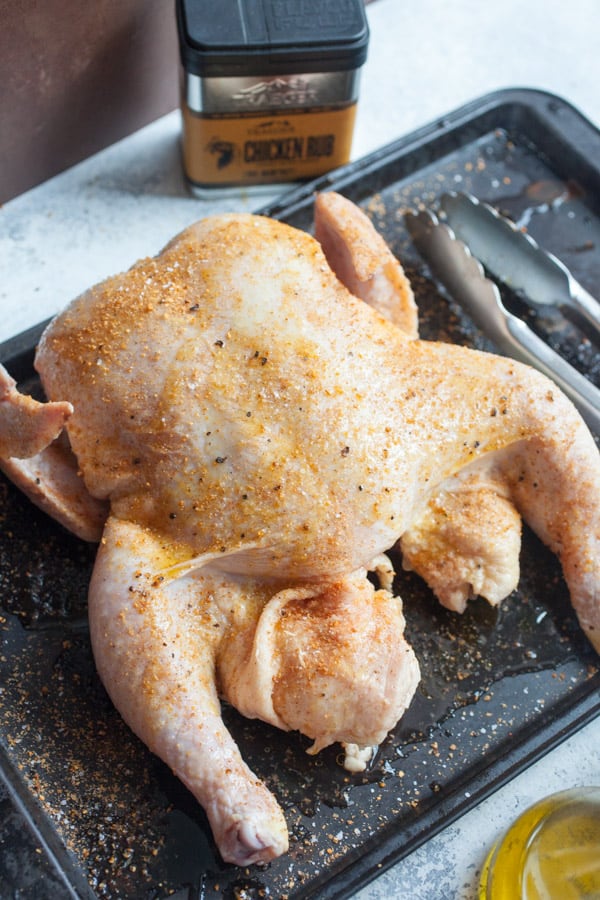
The Traeger cookbook, which is included with the grill, actually has pretty thorough instructions for roasting a chicken so I pretty much followed that for this chicken. I started off by preheating the grill and then added my chicken. Easy enough!
One bonus I’ll note is how much ROOM is in the grill. I think I could’ve fit three or four chickens on just the main grill level and I got the medium sized model.
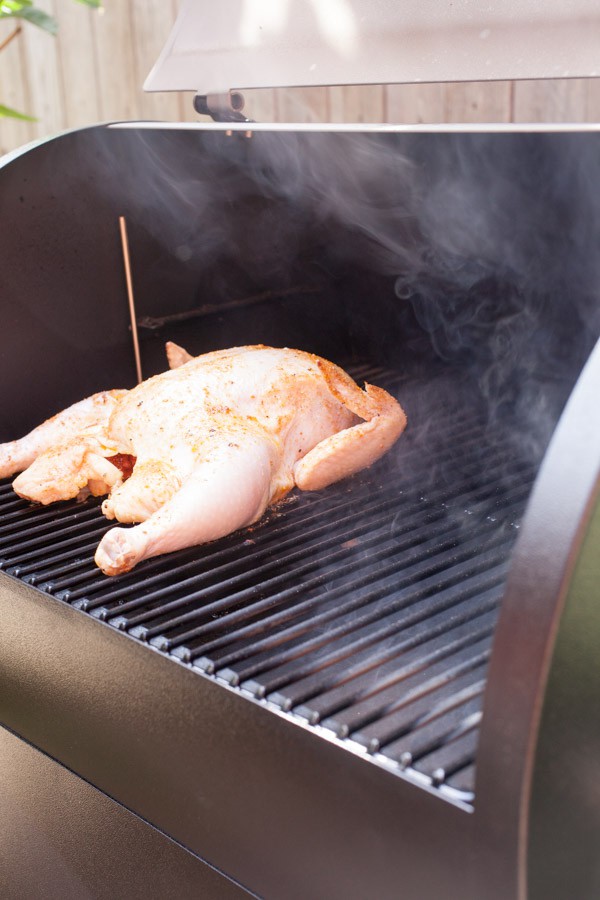
The problem with cooking a whole chicken on the grill, and why I like to use it to test grills, is that it’s pretty easy to burn the outer parts of the chicken while leaving the thicker parts uncooked.
Honestly, I was blown away at how the Traeger handled this. Once I got some decent color on both sides of the chicken (I cooked it for about 15 minutes per side on high heat), then I could turn the temperature down slightly and had zero worry about burning the chicken.
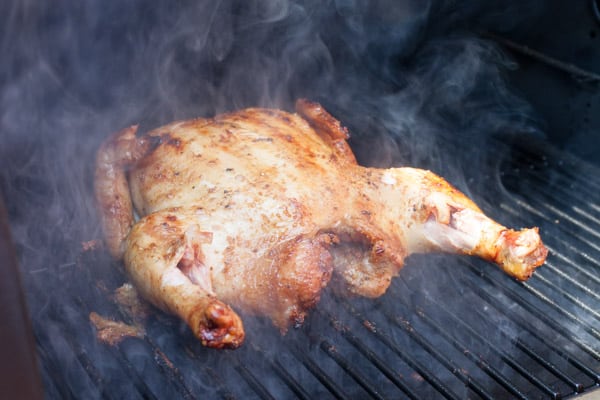
I was feeling pretty confident and so I tossed on a few Brussels Sprouts skewers as well just to test how the grill did with some sturdy veggies.
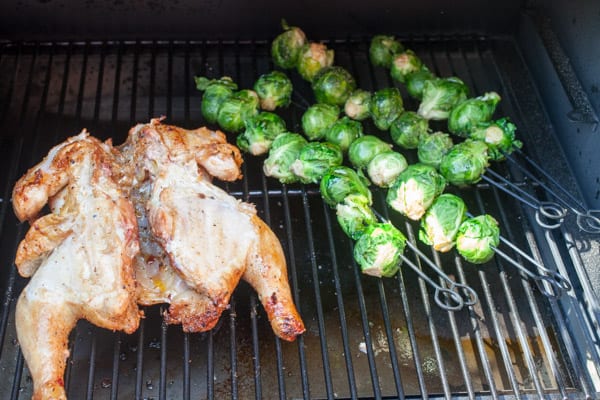
After about fifty minutes I thought my chicken looked done, but it was worth checking using their nifty probes. I’m obsessed with these because they plug right into the grill and you can toggle between probe temperature and grill temperature with one button.
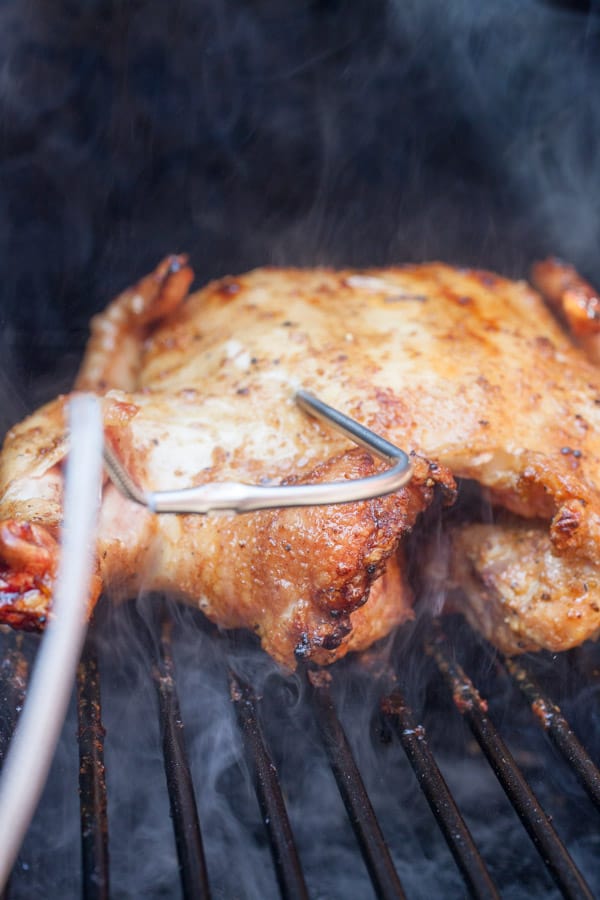
My chicken registered 135 degrees. NOT DONE! Glad I checked!
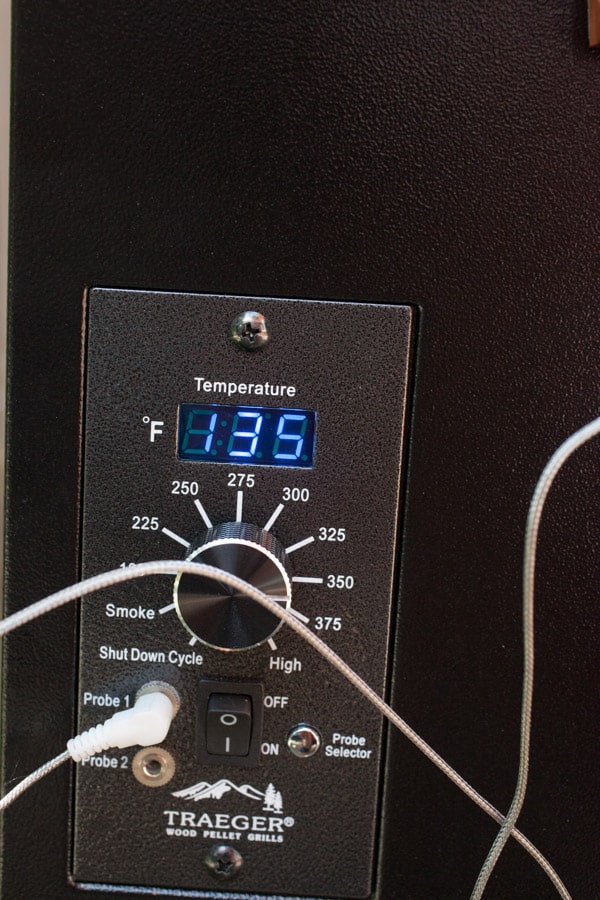
After about 20 more minutes on the grill, I hit the number I was going for and pulled my chicken off.
Just look at this beauty of a bird. Crispy skin, not at all burned, and the skin didn’t even stick to the grill.
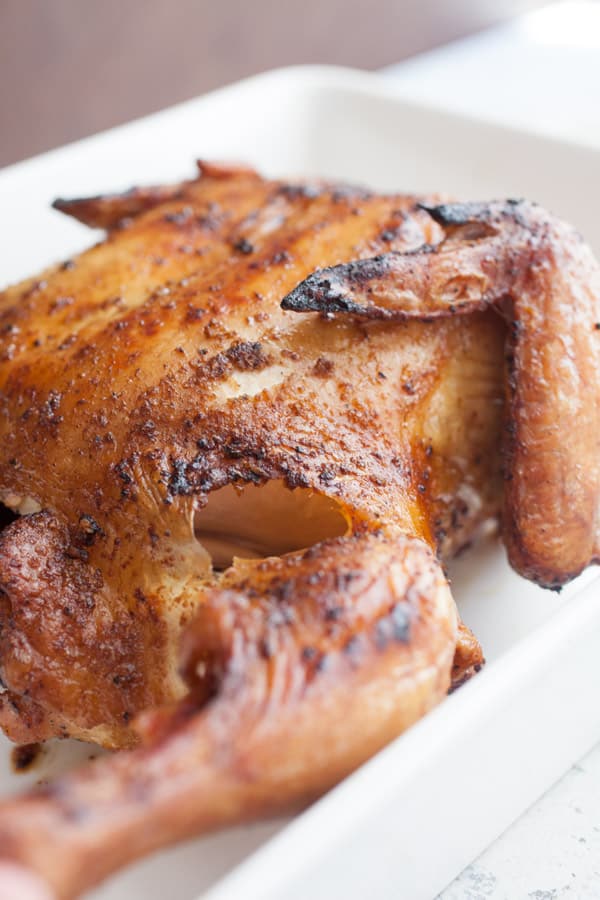
To be honest, I was a bit giddy with how my bird turned out so I tossed some chicken wings on as well.
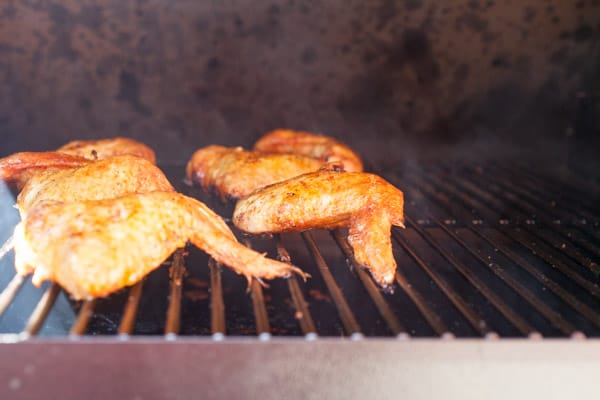
And here’s the part where I have to eat some crow.
I fancy myself a good griller and I would’ve loved to tell you that I made better chicken on a finicky charcoal grill or a gas grill, but it’s just not true. This chicken was easy to cook and it was the best grilled chicken I’ve ever made. I say that honestly and truly. I loved it and my family loved it.
Plus, look at those sprouts. They turned out pretty solid after 25 minutes or so on the grill as well!
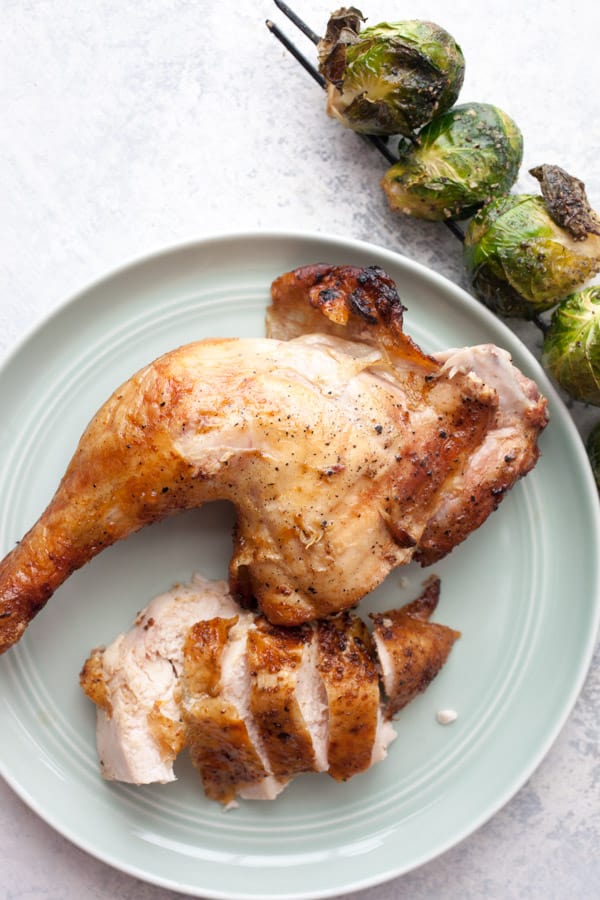
I couldn’t get over how juicy and delicious this was.
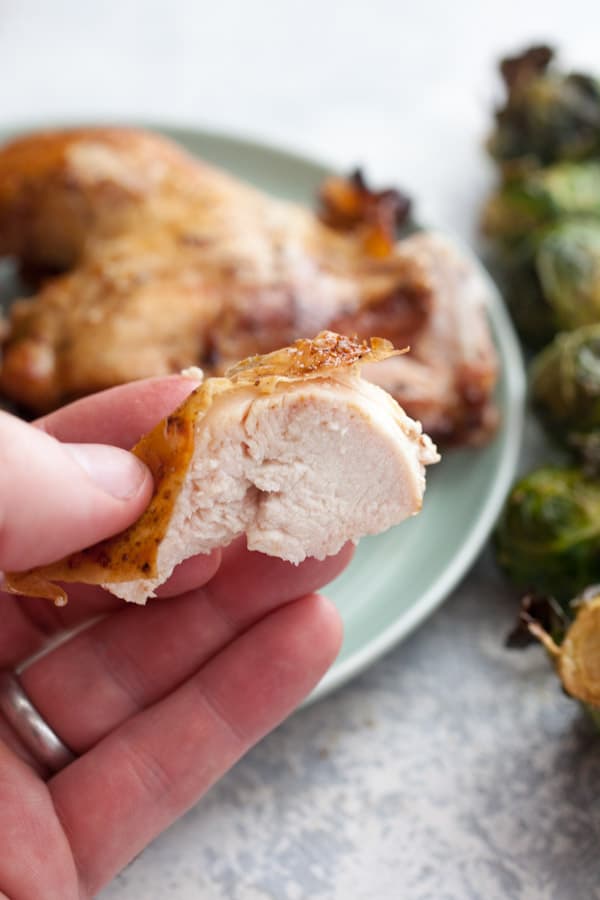
Sometimes technology and engineering is just amazing and the Traeger grill is truly great.
As with anything new, there will be some learning curves for a new Traeger user, but I was impressed with this grill. It made one of the best grilled chickens I’ve made and I, semi-embarrassingly, just followed the instructions in the book that came with the damn grill.

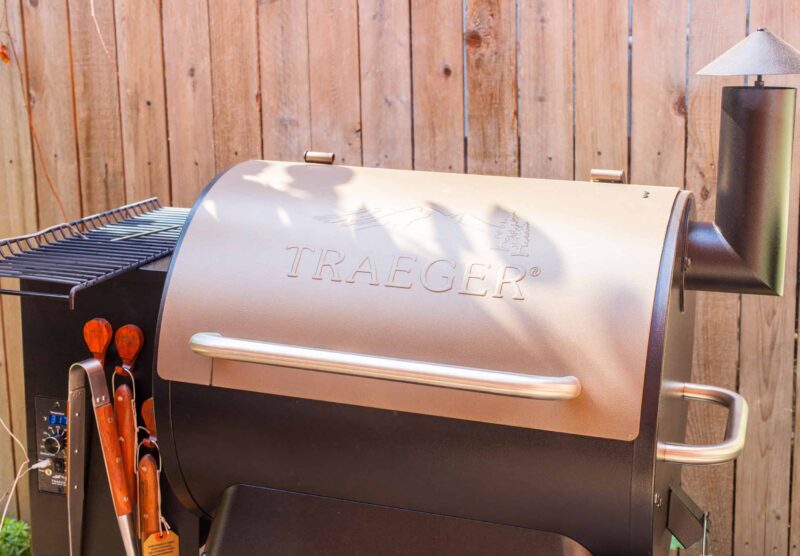

Alan Cram
Absolutely hate my Traeger! Temperature swings +/- 60 degrees. Called service and ended up hanging up after an hour on hold. I tried to send them an email and it came back undeliverable due to a full in box. Disgusted with this POS and thinking of demolishing it on YouTube.
Nick
Hey Alan! What model do you have??
Scooter
I personally love the experience & taste of the food products that come out of these grills.
However, I’ve discovered a design flaw & reported it to Trager and they’ve not acted to improve the product line.
Let me explain further, I was at a local Costco the other day and spoke to the Trager representatives about this grill and other models of its design. Those representatives sad they’ve never heard of the problem & never had a complaint. So I Left, went home, uncovered my grill & made a short video of what was happening with my grill. I then returned to Costco and played the video for the representative.
The problem: The pellet hopper that sits over the legs without the wheels comes loose. It’s not the augur section/firer box section it’s the hopper that mounts to these components. When moving the grill around you pick up this end by the handle attached to the hopper because the wheels are on the other end. (Moving the grill only inches/feet to get it away from the wall).
With this design & the numbers of these grills sold, I can’t believe that I’m the only person that has experienced this problem.
Traeger sent me out a complete hopper/auger/fire box assembly and I R & R with the new assembly. The concern has reoccurred because this is a design flaw.
The solution is simple if you are purchasing any grill make sure you are purchasing one where the hopper is sitting over the wheels, especially if you are moving the grill every time you’d use it.
Sidenote: it’s hilarious how one can’t post negative remarks to Traegers Canadian or US website.
Nick
Thanks for the comment Scooter! That’s interesting and I’ll be sure to watch for it on my model. To be honest, I haven’t moved mine much (like… at all). Thanks for the heads up though and I’ll be sure to report it back to the Traeger team the next time I talk to them.
Rayburn Neal
Uhh. Don’t pull your Traeger from that side. You should pull the Traeger from the side with the handle…???
Scooter
Yup, I’m now an expert…the wheels are on the other end which helps with the process of moving the Traeger, hence why one has to lift from the hopper end which has a handle and legs without wheels.
All in all, this is a poorly designed model by Traeger.
As per my previous post “The problem: The pellet hopper that sits over the legs without the wheels comes loose. It’s not the augur section/firer box section it’s the hopper that mounts to these components. When moving the grill around you pick up this end by the handle attached to the hopper because the wheels are on the other end.”
Hal Schaffer
After smoking a great Treager meal, we found our the smoker has carried a layer of gray glitter-like particles about 1/64 dia. all over our white cement patio every time we BBQ. What can we do to stop the particles from being carried out of the smoke stack? It seems that some of the particles appear to be unburned or just partially burned dust. Please help. We like the grill, but the ensuing mess is not acceptable.
Nick
Interesting Hal! I’m not sure I’ve ever heard of that… what model do you have? Have you tried contacting them directly?
TROY DESBIENS
I purchased a new Traeger Pro 22 (2) weeks ago and I have to say I am Very displeased with the way it cooks. I feel they do false advertising saying it’s a real grill. It’s a glorified outdoor oven that can smoke. I’ve been barbecuing for the past 40 years and at least 300 days a year for the past 9 years alone! Through the years Iv’e owned both charcoal and propane grills and was hoping to get away from both so cooking with wood appealed to me. I definitely should have done more research first! The Traeger is not a grill (doesn’t sear meat) and it takes forever to do preparation which is not something you want or can do during the week after working all day Geez…C’mon! It lacks of any good taste even with smoking and I’m actually sorry I purchased one. Now I guess I’m stuck with it. I really can’t see what benefit you see in it. Such an expensive travesty.
Nick
Hey Troy! Thanks for writing in man. If you are unhappy with it, I’d recommend contacting Traeger or the store. They might allow you to return it or you can almost certainly resell it to someone who might use it more. In my review I mentioned the same con about the high heat issue. I keep another grill handy just for searing as I agree that it isn’t great at that. I think I disagree though on the prep for the grill and the flavor. I’ve had good luck with it over the last year or so and have made a wide array of things on it. Of course, it’s not as flavorful as full wood BBQ might be, but for most home cooks I think it’s a really nice option.
Anyway, thanks for reporting back. Always good to hear from people who have tried it as it might help others make purchasing decisions. Happy grilling season sir!
Sailor
Classy company
Steve Ward
I just purchased a new Traeger, but there was not a cookbook with recipes anywhere to be found
Steve
I just purchased a new Traeger, but there was not a cookbook with recipes anywhere to be found
Sharon
Was excited to get the Traeger Tailgater, but have been disappointed with every meal. Recipes in their book don’t match temp/time settings on their videos. First 3 cooks meat was tough and overcooked. Thanksgiving turkey was a total fail that I threw it out! Raw in the center so cooked it for 2 more hours in the regular oven and it still was awful. I bought Traeger’s turkey brine/rub/pellets and did all the prep. Bought a fresh turkey which was more expensive but I didn’t want any issues. I plan to give this horrible grill to a friend and get my gas grill back. Hate it and so frustrated that I wasted so much money on it !
Nick Evans
Hey Sharon,
Sorry about your experience there. I must admit that I haven’t used that exact model of Traeger and reviewed their grill many years ago (although have used it a bunch since then). I’d recommend reaching out to their support. Maybe something is faulty in your model. Good luck!
Sharon
Ok thank you. A friend said maybe my probe is faulty. Appreciate your response.